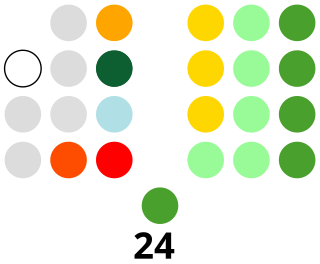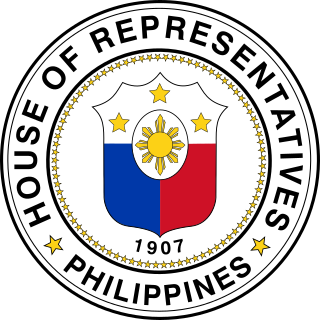
The Congress of the Philippines is the legislature of the national government of the Philippines. It is bicameral, composed of an upper body, the Senate, and a lower body, the House of Representatives, although colloquially, the term "Congress" commonly refers to just the latter. The Senate meets at the GSIS Building in Pasay, while the House of Representatives meets at the Batasang Pambansa in Quezon City, which also hosts joint sessions.

The House of Representatives is the lower house of Congress, the bicameral legislature of the Philippines, with the Senate of the Philippines as the upper house. The lower house is commonly referred to as Congress, although the term collectively refers to both houses.

The Senate of the Philippines is the upper house of Congress, the bicameral legislature of the Philippines, with the House of Representatives as the lower house. The Senate is composed of 24 senators who are elected at-large under a plurality-at-large voting system.
Elections in the Philippines are of several types. The president, vice-president, and the senators are elected for a six-year term, while the members of the House of Representatives, governors, vice-governors, members of the Sangguniang Panlalawigan, mayors, vice-mayors, members of the Sangguniang Panlungsod/members of the Sangguniang Bayan, barangay officials, and the members of the Sangguniang Kabataan are elected to serve for a three-year term.

William Ernest Mason was a Republican U.S. Representative and Senator from Illinois. He was the father of Winnifred Sprague Mason Huck.

The Jones Law was an Organic Act passed by the United States Congress. The law replaced the Philippine Organic Act of 1902 and acted as a constitution of the Philippines from its enactment until 1934, when the Tydings–McDuffie Act was passed. The Jones Law created the first fully elected Philippine legislature.
The legislative districts of Iloilo are the representations of the province of Iloilo in the various national legislatures of the Philippines. The province is currently represented in the lower house of the Congress of the Philippines through its first, second, third, fourth and fifth congressional districts.
The legislative districts of Cagayan are the representations of the province of Cagayan in the various national legislatures of the Philippines. The province is currently represented in the lower house of the Congress of the Philippines through its first, second, and third congressional districts.
The 5th Philippine Legislature was the meeting of the legislature of the Philippines under the sovereign control of the United States from 1919 to 1922.
The 6th Philippine Legislature was the meeting of the legislature of the Philippines under the sovereign control of the United States from 1922 to 1925.
The 7th Philippine Legislature was the meeting of the legislature of the Philippines under the sovereign control of the United States from 1925 to 1928.
The elections for the members of the Philippine Assembly were held on June 6, 1916 pursuant to the Philippine Organic Act of 1902 which prescribed elections for every three years. After the passage of the Jones Law on August 29, 1916 in where the Philippine Assembly would be replaced by the House of Representatives of the Philippines or the Lower House, the elected members of the Philippine Assembly would be automatically members of the new House of Representatives.
Elections for the Philippine Legislature were held on June 3, 1919, pursuant to the Philippine Organic Act of 1902 which prescribed elections for every three years. Voters elected all 90 members of the House of Representatives in the 1919 Philippine House of Representatives elections; and all 22 members of the Senate in the 1919 Philippine Senate elections.
Elections for the members of the House of Representatives were held on June 6, 1922, pursuant to the Philippine Organic Act of 1902, which prescribed holding elections every three years. The ruling Nacionalista Party was split into the Colectivista and the Unipersonalista factions. If combined, both blocs formed the largest party grouping in the House, with 64 of the 93 members. The Democrata Party emerged as the strongest opposition party since then Progresistas of the 1910s, winning 25 seats.
Elections to the Philippine Legislature were held on June 5, 1928 pursuant to the Philippine Organic Act of 1902 which prescribed elections for every three years. Votes elected 94 members of the House of Representatives in the 1928 Philippine House of Representatives elections; and 24 members of the Senate in the 1928 Philippine Senate elections.
Elections to the Philippine Legislature were held on June 2, 1925, pursuant to the Philippine Organic Act of 1902 which prescribed elections for every three years. Votes elected 90 members of the House of Representatives in the 1925 Philippine House of Representatives elections; and 24 members of the Senate in the 1925 Philippine Senate elections.
Elections for the members of the House of Representatives were held on June 2, 1925 pursuant to the Philippine Organic Act of 1902 which prescribed elections for every three years. The ruling Nacionalista Party, which was split into Colectivista and Unipersonalista factions in 1922, were reconciled and were named as the Nacionalista Consolidado Party. The party continued their hold of the House of Representatives retaining their number of seats from the previous election, and the majority.
Elections to the Congress of the Philippines were held on May 11, 1987. Voters elected the members of Congress in the following elections:




